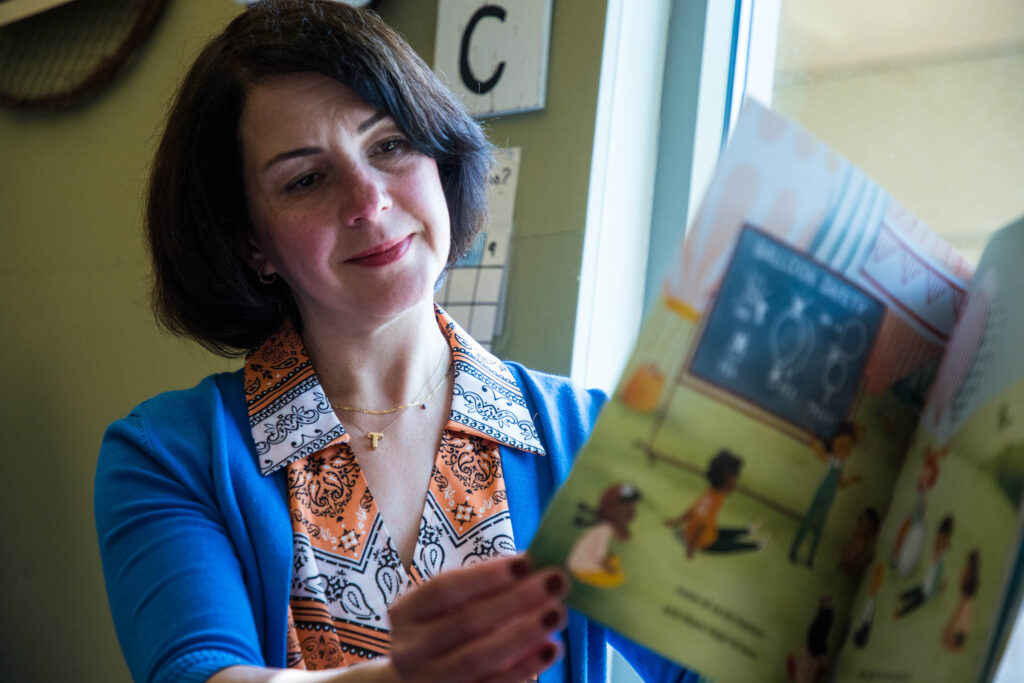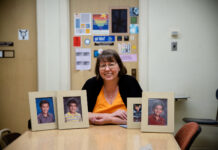
Tracy Hovsepian knows first hand what the struggle to navigate different cultures entails. Hovsepian’s family are ethnic Armenians, part of a Christian minority who lived peacefully in Iran, where she was born, for generations, until Ayatollah Khomeini rose to power in 1979.
“After the revolution, the regime changed, and it became an extremist Islamic regime,” Hovsepian said. “That’s when a lot of people’s basic rights and needs weren’t met.”
Life was difficult for her family during those years.
“I grew up during and after the revolution,” Hovsepian said. “You know, there was a lot of oppression, and life was not good over there. We didn’t have basic freedoms in any aspect. Economically, everything was very hard.”
Hovsepian, 49, immigrated to the United States with her husband when she was 27 years old. She understands the kind of adjustment it takes to suddenly enter a new world where everyone, and everything, is strange and new.
Now, as a Lead Master Teacher at Pierce College Child Development Center, she works to ensure that every child in her care enters the center feeling supported.
“My goal, as a child steps into the classroom, is to feel safe, to feel belonging, and connected. So, my first job is to establish that relationship with the child,” Hovsepian said.
Los Angeles is a city renowned for its rich cultural diversity, and the center reflects this: one third of the students arriving in their classrooms speak a language other than English at home. Hovsepian, conveniently, speaks four languages fluently, which helps her bridge the intimidating cultural divide many students face.
When Hovesepian immigrated, the contrast between her former life in Iran, and her new life in California, was great.
In Iran, “we had to wear scarves to go out, you know. At school, we had to learn Quran, that wasn’t even my religion. So there was a lot of oppression and all these things imposed on us,” she said.
But, when she arrived in the United States, Hovsepian felt this was where she was meant to be.
“Immigrating here to America, for me, it was like our dream,” she said.
Hovsepian, like most immigrants, faced many hurdles, but she was eager to adjust to her new life.
“Just having the basic freedom was already like, wow, this is what it is to have a normal life,” she said.
Hovsepian speaks English, Armenian, Farsi and French. She already had a bachelor’s degree in French and Farsi translation, and experience working in the import and export field, before arriving in America. Her cultural expertise has served her well in her teaching career here, helping other families adjust to a new way of life.
The Center’s director, Melissa Brisbois, said Hovsepian has been instrumental in helping newly-arrived families settle in.
“We do have a lot of families that are coming here from other countries, for various reasons. And sometimes language might be a barrier, like when we’re trying to get children and families signed up, to come into the center. As you can imagine, it’s a lot of paperwork,” Brisbois explained.
That is where Hovsepian’s personal experience has proven to be such an asset.
“Because she has been in that situation, she is always willing to come up to help us work with those families,” Brisbois said.
If a new student happens to speak a language Hovsepian doesn’t know, she attempts to learn keywords to help them feel safe, and establish a sense of belonging.
“I have a Russian child who just immigrated from Russia, and he didn’t speak any English at all. And we’ve been trying to include words in his language to make him feel welcome. So, it’s kind of like a really, really, fun challenge to try to use those languages. And it’s really, really – you can see their eyes lighting up when they hear their home language. Of course, we make sure that we alternate, and we create a great balance, so they also start developing the English language,” she said.
Hovesepian credits her daughter for sparking the change that motivated her to switch careers from business to teaching. After starting a family of her own, Hovsepian considered taking some college classes at Pierce. Enrolling her then 3-year-old daughter at the college’s preschool seemed the next logical step, and she was impressed with the positive results when her child joined a class.
“I put my daughter there and, you know, it made a huge difference in her social emotional skills, and her growth and development,” she said.
Her daughter’s progress motivated Hovsepian to enroll in a class in child development herself, which opened the door to a whole new world.
“I took one class, just to see, and I fell in love with it,” she said.
Early learning classes answered many of the questions she had as a parent.
“The discovery of – oh my gosh, just everything makes sense. And I love it. And that was what I wanted to do with my own child, because when she was three, I really wanted to know how I could be a better parent,” she explained.
Hovsepian went on to get her teaching qualifications and has been a lead teacher at the center since 2013, working with children aged 3 to 5. As they are a lab school, she has been instrumental in training new student teachers enrolled in the Child Development program at the college.
Her teaching assistant, Sianya Gallardo, who considers Hovsepian her mentor, said that she has learned a lot from her during the seven years they have worked together.
“She’s an inspiration. Honestly, you know, she puts children’s needs first. She strongly believes in play-based education for children, which I completely, 100% stand behind as well,” Gallardo said.
Gallardo describes Hovsepian as having a special knack for relating to the children in her care,
“She has a very warm personality. She smiles a lot, she’s always smiling. Children gravitate towards her,” Gallardo said.
Gallardo, who also studied in Pierce’s Child Development program, sensed from the beginning that they would be a good fit in the classroom together.
“When I did my practicum, my volunteer hours, I was assigned to Tracy’s room. And I just knew this was the place for me,” she said. They have been working together ever since.
Director Brisbois commented on the personal touch Hovsepian delivers to the students in her classroom.
“What I appreciate about her is that every child of hers is an individual,” Brisbois said.
Brisbois noted that Hovsepian made an effort to personalize classes to meet the children’s individual needs.
“She is not just creating a classroom curriculum, or a group time, or art activity, based on just a checklist,” she said.
Though it is not an easy job, Hovsepian takes it in stride, according to the director.
“There are times when we have challenging children, with challenging behaviors, due to life circumstances. You know, she’s always reaching out to those parents to meet with them. What can we do, how can we bridge that gap between home and school?” Brisbois said.
Tracy Hovsepian is firmly settled into life at Pierce College, which has become something of a family tradition as well. Her daughter, now 20, has completed a year of classes at Pierce, and her brother, Alan Hovsepian, works in the college’s IT Department.
In terms of advice, Hovsepian advocates that students considering a career in early childhood education maintain a growth mindset.
“You have to continue, until the last day you work with children, continue to learn. Educate yourself, grow, and keep up with new research, new strategies. We continually do training and professional development. You have to keep up, you cannot get stuck,” she said.
Reflecting on her time working at the center, Hovsepian expressed her gratitude for the cooperation and camaraderie she has experienced there.
“I am surrounded by very professional, amazing, respectful people, our staff, our teachers, our director. And we all follow the same philosophy, very supportive of each other. And it’s a place where I continue to find enough challenges, creatively. You know, good communities. I’m, very, very, very
grateful and blessed to be part of Pierce College, and more specifically the Child Development Center,” Hovsepian said.


